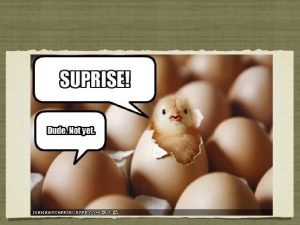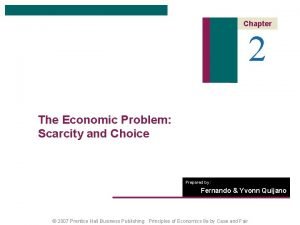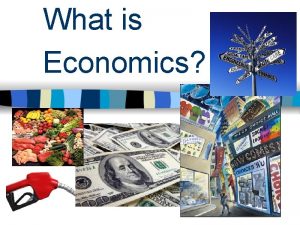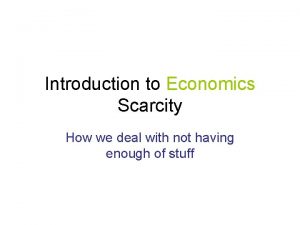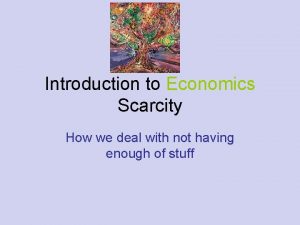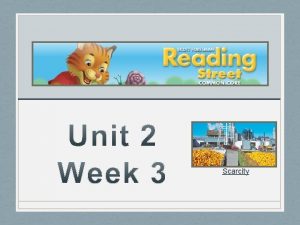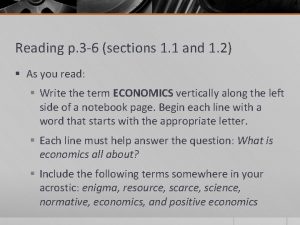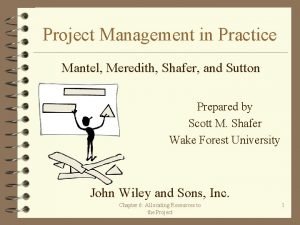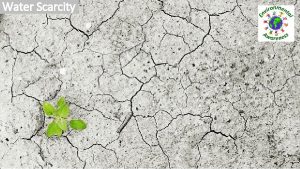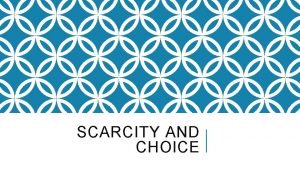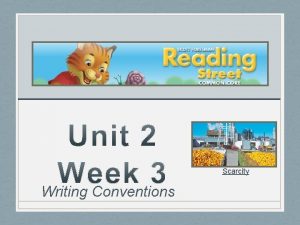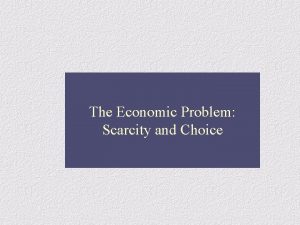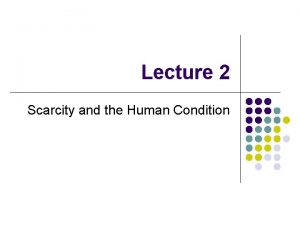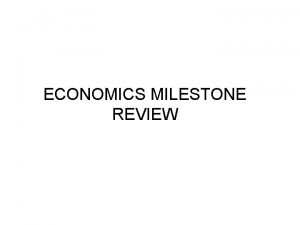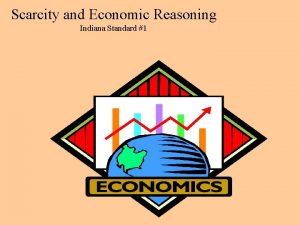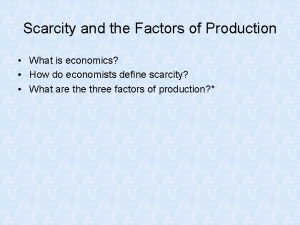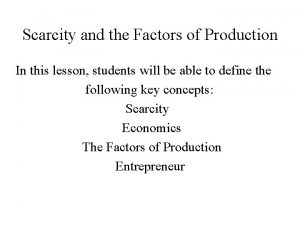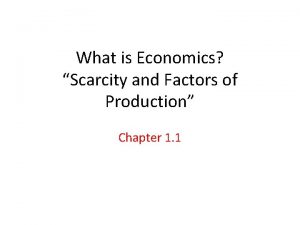Learning Goals Scarcity and the Factors of Production




















- Slides: 20

Learning Goals: Scarcity and the Factors of Production • Explain why scarcity and choice are basic problems of economics. • Identify land, labor, and capital as the three factors of production, and identify the two types of capital. Chapter 1 Section Main Menu

Bell ringer • What comes to mind when you hear the word scarce? • What are some items that you think might be scarce? Chapter 1 Section Main Menu

What Is Economics? • Economics is the study of how people make choices to satisfy their wants • For example: – You must choose how to spend your time – Businesses must choose how many people to hire Chapter 1 Section Main Menu

Scarcity and Shortages • Scarcity occurs when there are limited quantities of resources to meet unlimited needs or desires • Shortages occur when producers will not or cannot offer goods or services at current prices • Shortages can be temporary or long-term, but scarcity always exists – Why? – What may cause a temporary shortage for a good? Chapter 1 Section Main Menu

The Factors of Production • Land All natural resources that are used to produce goods and services. – Examples? • Labor Any effort a person devotes to a task for which that person is paid. – Examples? • Capital Any human-made resource that is used to create other goods and services. – Examples? Chapter 1 Section Main Menu

The Factors of Popcorn Production Land Labor Capital Popping Corn The human effort needed to pop the corn Corn-Popping Device • Provide another example of land, labor, and capital • What do you think is the different between physical capital and human capital? Chapter 1 Section Main Menu

Scarcity Activity • Do you think that time can be considered a resource? • Consider whether or not time is a scarce resource – Create a chart that shows how, in a typical weekday, you allocate the 24 hours available to you. Chapter 1 Section Main Menu

Learning Goals: Opportunity Cost • Describe why every decision involves tradeoffs. • Explain the concept of opportunity cost. • Explain how people make decisions by thinking at the margin. Chapter 1 Section Main Menu

Bell ringer • Choose ONE of the following vacation destinations and be prepared to explain your choice: – Hawaii – Puerto Vallarta, Mexico – Paris, France – The Bahamas – Las Vegas Chapter 1 Section Main Menu

Trade-offs and Opportunity Cost • Trade-offs are all the alternatives that we give up whenever we choose one course of action over others. – Examples for individuals? – Examples for businesses? – Examples for society (guns vs. butter)? • The most desirable alternative given up as a result of a decision is known as opportunity cost. – Write a definition of opportunity cost in your own words and provide examples from your own life Chapter 1 Section Main Menu

The Decision-Making Grid • Economists encourage us to consider the benefits and costs of our decisions. Karen’s Decision-making Grid Alternatives Sleep late Wake up early to study Benefits • Enjoy more sleep • Have more energy during the day • Better grade on test • Teacher and parental approval • Personal satisfaction Decision • Sleep late • Wake up early to study for test Opportunity cost • Extra study time • Extra sleep time Benefits forgone • Better grade on test • Teacher and parental approval • Personal satisfaction • Enjoy more sleep • Have more energy during the day Chapter 1 Section Main Menu

Thinking at the Margin • When you decide how much more or less to do, you are thinking at the margin. • Decisions aren’t always “all or nothing” Chapter 1 Options Benefit Opportunity Cost 1 st hour of extra study time Grade of C on test 1 hour of sleep 2 nd hour of extra study time Grade of B on test 2 hours of sleep 3 rd hour of extra study time Grade of B+ on test 3 hours of sleep Section Main Menu

Decision Making at the Margin • Decide whether to work 2, 4, or 6 hours at an afterschool job by comparing the opportunity cost and benefit of each alternative. Chapter 1 Section Main Menu

Global Trade-Offs • How can the same decision made in two different countries have vastly different opportunity costs? Chapter 1 Section Main Menu

Learning Goals: Production Possibilities Graphs • Identify key points on a production possibilities curve. • Demonstrate how production possibilities curves show efficiency, growth, and cost. • Explain why a country’s production possibilities depend on its available resources and technology. Chapter 1 Section Main Menu

Production Possibilities • A production possibilities graph shows alternative ways that an economy can use its resources. • The production possibilities frontier is the line that shows the maximum possible output for that economy. Production Possibilities Graph 25 0 15 8 14 14 12 18 9 20 5 21 0 Shoes (millions of pairs) Watermelons Shoes (millions of tons) (millions of pairs) 20 15 5 Section b (8, 14) c (14, 12) 10 0 Chapter 1 a (0, 15) d (18, 9) A production possibilities frontier e (20, 5) f (21, 0) 5 10 15 20 25 Watermelons (millions of tons) Main Menu

Efficiency Chapter 1 Section Production Possibilities Graph 25 Shoes (millions of pairs) • Efficiency means using resources in such a way as to maximize the production of goods and services. An economy producing output levels on the production possibilities frontier is operating efficiently. 20 S 15 a (0, 15) 10 b (8, 14) c (14, 12) g (5, 8) 5 d (18, 9) e (20, 5) A point of underutilization 0 5 10 f (21, 0) 15 20 Watermelons (millions of tons) Main Menu 25

Growth • Give specific examples of what would cause shifts to the right and left. Production Possibilities Graph 25 Future production Possibilities frontier T Shoes (millions of pairs) • Growth If more resources become available, or if technology improves, an economy can increase its level of output and grow. When this happens, the entire production possibilities curve “shifts to the right. ” 20 S 15 a (0, 15) b (8, 14) c (14, 12) 10 d (18, 9) 5 e (20, 5) f (21, 0) 0 5 10 15 20 Watermelons (millions of tons) Chapter 1 Section Main Menu 25

Cost • Cost A production possibilities graph shows the cost of producing more of one item. To move from point c to point d on this graph has a cost of 3 million pairs of shoes. Production Possibilities Graph 25 0 15 8 14 14 12 18 9 20 5 21 0 Shoes (millions of pairs) Watermelons Shoes (millions of tons) (millions of pairs) 20 15 c (14, 12) 10 5 0 Chapter 1 Section d (18, 9) 5 10 15 20 25 Watermelons (millions of tons) Main Menu

Problem Solving • How would you illustrate the impact of each of the following events on a productions possibilities curve for factory goods and farm goods? – The computer is invented – 1 million farm workers remain unemployed for six months – A drought Chapter 1 Section Main Menu
 Strategic goals tactical goals operational goals
Strategic goals tactical goals operational goals Strategic goals tactical goals operational goals
Strategic goals tactical goals operational goals Carta alir proses pembuatan produk
Carta alir proses pembuatan produk General goals and specific goals
General goals and specific goals Examples of generic goals and product-specific goals
Examples of generic goals and product-specific goals Objectives of egg production
Objectives of egg production Definition of scarcity in economics
Definition of scarcity in economics Explain scarcity and choice
Explain scarcity and choice Scarcity, choice and opportunity cost example
Scarcity, choice and opportunity cost example Relationship between economics and scarcity
Relationship between economics and scarcity Cuadro comparativo e-learning y b-learning
Cuadro comparativo e-learning y b-learning People with all their efforts, abilities, and skills
People with all their efforts, abilities, and skills The basic economic problem results from scarcity.
The basic economic problem results from scarcity. Scarcity lesson plan
Scarcity lesson plan Scarcity def
Scarcity def Causes of scarcity
Causes of scarcity Scarcity sentence
Scarcity sentence Scarcity forces tradeoffs symbol
Scarcity forces tradeoffs symbol Scarcity entrepreneurship definition
Scarcity entrepreneurship definition Resources scarcity
Resources scarcity Resources scarcity
Resources scarcity





